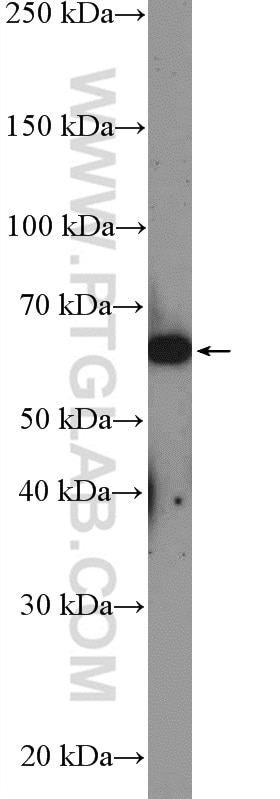Anticorps Polyclonal de lapin anti-LOXL1
LOXL1 Polyclonal Antibody for WB,ELISA
Hôte / Isotype
Lapin / IgG
Réactivité testée
Humain
Applications
WB, ELISA
Conjugaison
Non conjugué
N° de cat : 26608-1-AP
Synonymes
Galerie de données de validation
Applications testées
| Résultats positifs en WB | cellules MCF-7 |
Dilution recommandée
| Application | Dilution |
|---|---|
| Western Blot (WB) | WB : 1:500-1:2000 |
| It is recommended that this reagent should be titrated in each testing system to obtain optimal results. | |
| Sample-dependent, check data in validation data gallery | |
Applications publiées
| WB | See 1 publications below |
Informations sur le produit
26608-1-AP cible LOXL1 dans les applications de WB, ELISA et montre une réactivité avec des échantillons Humain
| Réactivité | Humain |
| Réactivité citée | Humain |
| Hôte / Isotype | Lapin / IgG |
| Clonalité | Polyclonal |
| Type | Anticorps |
| Immunogène | LOXL1 Protéine recombinante Ag24293 |
| Nom complet | lysyl oxidase-like 1 |
| Masse moléculaire calculée | 63 kDa |
| Poids moléculaire observé | 63 kDa |
| Numéro d’acquisition GenBank | BC015090 |
| Symbole du gène | LOXL1 |
| Identification du gène (NCBI) | 4016 |
| Conjugaison | Non conjugué |
| Forme | Liquide |
| Méthode de purification | Purification par affinité contre l'antigène |
| Tampon de stockage | PBS avec azoture de sodium à 0,02 % et glycérol à 50 % pH 7,3 |
| Conditions de stockage | Stocker à -20°C. Stable pendant un an après l'expédition. L'aliquotage n'est pas nécessaire pour le stockage à -20oC Les 20ul contiennent 0,1% de BSA. |
Informations générales
Three LOXL1 variants are seen: a band of 64 kDa matching the predicted full-length form lacking the secretory signal peptide, a band of 67 kDa presumed to be the full-length form with the signal peptide, and a band of 36 kDa matching the cleavage product.
Protocole
| Product Specific Protocols | |
|---|---|
| WB protocol for LOXL1 antibody 26608-1-AP | Download protocol |
| Standard Protocols | |
|---|---|
| Click here to view our Standard Protocols |
Publications
| Species | Application | Title |
|---|---|---|
Front Oncol Lysyl oxidase-like 4 exerts an atypical role in breast cancer progression that is dependent on the enzymatic activity that targets the cell-surface annexin A2 |


